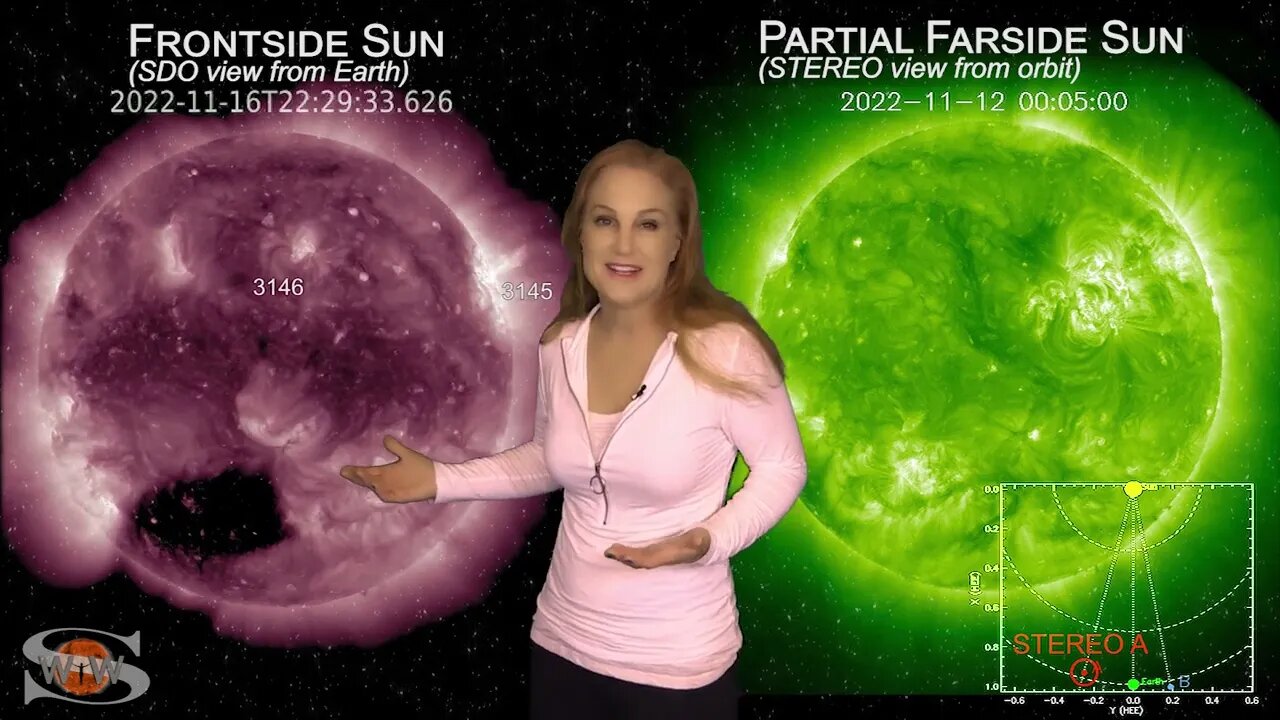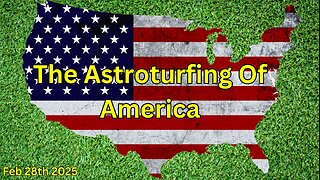Premium Only Content

A Dark Coronal Hole & New Bright Regions | Space Weather News 11.17.2022
This Space Weather News forecast sponsored in part by Millersville University:
https://www.millersville.edu/swen
Our Sun switches gears this week as the set of active regions that gave us some big flares and radio blackouts last week rotates to the Sun's farside and a dark coronal hole begins to rotate into the Earth-strike zone. This means radio communications on Earth's dayside will improve, and aurora possibilities on Earth's nightside increase. Fast solar wind is expected to hit Earth starting around the 19th and could bring aurora down into mid-latitudes for a short while. Aurora photographers at high latitudes have a better chance as a glancing passage for a solar storm could enhance conditions starting even earlier, possibly by late on the 17th. GPS users should stay vigilant around dawn and dusk and anywhere near aurora over the next few days as it could impact signal reception. Lean the details of the coming fast solar wind and the glancing solar storm blow (the specific NASA solar storm model run I reference can be found here: https://iswa.gsfc.nasa.gov/downloads/20221114_102400_2.0_anim.tim-den.gif ), find out where aurora may be visible, and see why amateur radio operators smile while GPS users stay cautiously optimistic this week.
Want early access to these forecasts, tutorials on Space Weather, & more? Visit:
https://patreon.com/SpaceweatherWoman
For daily and often hourly updates (during active times) visit me on Twitter:
https://twitter.com/TamithaSkov
For a more in-depth look at the data and images highlighted in this video see these links below.
Solar Imaging and Analysis:
SDO: http://sdo.gsfc.nasa.gov/data/
Helioviewer: http://www.helioviewer.org/
Flare Analysis: http://www.lmsal.com/solarsoft/latest_events/
Computer Aided CME Tracking CACTUS: http://www.sidc.oma.be/cactus/out/latestCMEs.html
GOES Xray: http://www.swpc.noaa.gov/rt_plots/xray_1m.html
SOHO: http://sohodata.nascom.nasa.gov/
Stereo: http://stereo.gsfc.nasa.gov/
GONG magnetic field synoptic movie: https://gong.nso.edu/data/magmap/standard_movie.html
GONG magnetic field synoptic charts: http://gong.nso.edu/data/magmap/
LMSAL Heliophysics Events HEK http://www.lmsal.com/isolsearch
Solar Wind:
DISCOVR solar wind: http://www.swpc.noaa.gov/products/real-time-solar-wind
ACE Solar Wind: http://www.swpc.noaa.gov/products/ace-real-time-solar-wind
NASA ENLIL SPIRAL: https://iswa.gsfc.nasa.gov/IswaSystemWebApp/iSWACygnetStreamer?timestamp=2038-01-23+00%3A44%3A00&window=-1&cygnetId=261
NOAA ENLIL SPIRAL: http://www.swpc.noaa.gov/products/wsa-enlil-solar-wind-prediction
Magnetosphere, Ionosphere, Atmosphere:
GOES Magnetometer: http://www.swpc.noaa.gov/products/goes-magnetometer
Ionosphere D-Region Absorption (DRAP) model: http://www.swpc.noaa.gov/products/d-region-absorption-predictions-d-rap/
Radio Propagation: https://www.tvcomm.co.uk/g7izu/atlantic-mf-hf-propagation-20min-persistence/
Near-Earth radiation environment: https://spaceweather.gfz-potsdam.de/products-data/forecasts
Auroral Oval Ovation Products: http://www.swpc.noaa.gov/products/aurora-30-minute-forecast
Global 3-hr Kp index: http://www.swpc.noaa.gov/products/planetary-k-index
Wing Kp index prediction: http://www.swpc.noaa.gov/products/wing-kp
USGS Ground Magnetometers: http://geomag.usgs.gov/realtime/
USGS Disturbance Storm-Time (Dst): http://geomag.usgs.gov/realtime/dst/
NAIRAS Radiation Storm Model: http://sol.spacenvironment.net/raps_ops/current_files/globeView.html
Multi-Purpose Space Environment Sites:
NOAA/SWPC: http://www.swpc.noaa.gov
SOLARHAM: http://www.solarham.net/index.htm
Spaceweather: http://spaceweather.com
iSWA: http://iswa.gsfc.nasa.gov/iswa/iSWA.html
Definition of Geomagnetic Storm, Radiation Storm, and Radio Blackout Levels:
http://www.swpc.noaa.gov/NOAAscales/
None of this would be possible without the hard work and dedication of those who have provided all of this data for public use.
Images c/o NASA/ESA/CSA (most notably the superb SDO, SOHO, ACE, STEREO, CCMC, JPL & DSN teams, amazing professionals, hobbyists, institutions, organizations, agencies and amateurs such as those at the USAF/HAARP, NICT, NOAA, USGS, Environment Canada, Natural Resources Canada, Intellicast, Catatania, rice.edu, wisc.edu, sonoma.edu ucalgary.ca, rssi.ru, ohio-state.edu, solen.info, and more. Thanks for making Space Weather part of our every day dialogue.
-
 9:46
9:46
Dr. Tamitha Skov
1 year ago $0.02 earnedDark Farside Regions Come with Aurora & Meteors for New Years | Space Weather News 30 December 2023
1881 -
 LIVE
LIVE
Right Side Broadcasting Network
3 hours agoLIVE: President Trump and Ukrainian President Zelenskyy Meet and Hold a Press Briefing - 2/28/25
5,894 watching -
 LIVE
LIVE
LFA TV
16 hours agoBODYCAM FOOTAGE OF TRAFFIC STOP! | LIVE FROM AMERICA 2.28.25 11AM
4,578 watching -
 LIVE
LIVE
The Big Mig™
4 hours agoGlobal Finance Forum From Bullion To Borders We Cover It All
2,157 watching -
 31:13
31:13
Tudor Dixon
2 hours agoThe Last Supper with Chris Tomlin | The Tudor Dixon Podcast
95 -
 48:58
48:58
BonginoReport
4 hours agoFake Epstein Files Fallout + Will Cain on the Government’s Internal Civil War (Ep.150) - 02/28/2025
119K243 -
 22:54
22:54
Clownfish TV
12 hours agoJournalists are RAGE QUITTING! Mainstream Media's Free Ride is OVER!
22.6K4 -
 3:25:28
3:25:28
Matt Kohrs
10 hours agoMarket Crash, Inflation Report & Payday Friday || The MK Show
67.7K8 -
 2:59:07
2:59:07
Wendy Bell Radio
7 hours agoThe Astroturfing Of America
90.9K53 -
 1:52:53
1:52:53
Game On!
17 hours ago $5.47 earnedTampa Bay Welcomes Jon Gruden BACK!
61.7K1